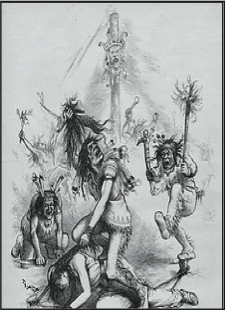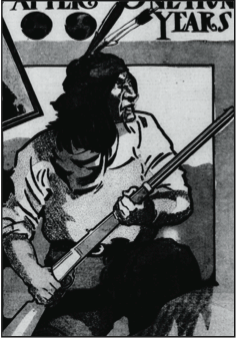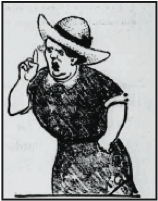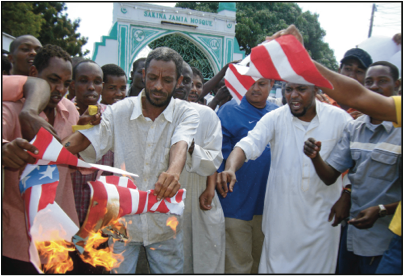From Elon Journal of Undergraduate Research in Communications VOL. 4 NO. 1Visual Persuasion: The Media's Use of Images in Framing People GroupsIX. ConclusionThroughout American history, the media have repeatedly been used to frame the understanding of groups of people outside of the traditionally understood boundaries of "white America" and outline the context and dictate the conversation surrounding them, thereby creating a new identity for them: "In no place on earth has the daily production of news formed such an integral part of people's images of themselves – of a national narrative – as in the United States."64 While the exact media tactics used against each group differed slightly, the press was successfully able to frame each in response to a catalyst that made each a threat, thereby protecting the status quo of white male America. By emphasizing cultural differences, downplaying any ties to American identity, and, in some cases, resorting to blatant name calling, the groups were framed as "the other." Many of these images have endured as representations of the struggles faced by groups on the march to equality, standing as reminders of former, misguided fears. It goes without saying that the press did improve in the more than 100 years between the Indian Wars and 9/11; however, weaknesses still exist, and framing is a major problem that must be addressed by the American media system in order to mitigate the negative effects felt by groups of people being covered by the press. As evidenced repeatedly throughout history, and specifically in these five cases, framing tactics are often employed by the media in targeted attacks designed to shape the public's understanding of an event or group of people considered outside of the status quo. While the common understanding of what this "norm" entails has changed over the course of many years, there will always be a group "outsiders" who find themselves under the scrutiny of the press. AcknowledgmentsThe author is indebted to Dr. David Copeland, at Elon University, for his guidance, inspiration, and advice without which this article could not be published. The author also appreciates the numerous reviewers who helped during the process of revision. Endnotes1 .) Matt Evans, "Framing International Conflicts: Media Coverage of Fighting in the Middle East," International Journal of Media and Cultural Politics 6.2 (2010): 209-210. 2 .) Robert Entman, "Framing Bias: Media in the Distribution of Power," Journal of Communications 57 (2007): 164. 3 .) Gerald Kosicki and Zhongdang Pan, "Framing Analysis: An Approach to News Discourse," Political Communication 10 (1993): 55-75. 4 .) Robert Entman, "Framing: Towards Clarification of a Fractured Paradigm," Journal of Communication 43.4 (1991): 52. 5 .) Ibid, 52. 6 .) Lesley Cowling, "The Media and the Production of the Public Debate," Social Dynamics 36.1 (2010): 78. 7 .) Entman, "Framing Bias: Media in the Distribution of Power," 164. 8 .) Cowling, "The Media and the Production of the Public Debate," 83. 9 .) Ibid, 79. 10 .) Theodore Glasser, "Objectivity Precludes Responsibility," The Quill (1984). Cited by Scott London in "How the Media Frames Political Issues," 1993, http://bit.ly/ScottLondon. Accessed Nov. 17, 2012. 11 .) Rosalee Clawson, Thomas Nelson, and Zoe Oxley. "Media Framing of a Civil Liberties Conflict and its Effect on Tolerance," American Political Science Review 91.3 (1997): 568. 12 .) Cowling, "The Media and the Production of the Public Debate," 83. 13 .) Ibid. 14 .) Ibid. 15 .) Walter Lippman, Public Opinion (New York: Harcourt, Brace & Co., 1922): 81. Cited by Juan Gonzalez and Joseph Torres, News for All the People: The Epic Story of Race and the American Media (London: Verso, 2011): 3. 16 .) Frankie Hutton and Barbara Straus Reed, eds., Outsiders in 19th-Century Press History: Multicultural Perspectives (Bowling Green: Bowling Green University Popular Press, 1995), 1. 17 .) John Lofton, The Press as Guardian of the First Amendment (Columbia: University of South Carolina Press, 1980), 279. 18 .) Dietram Scheufele. "Framing as a Theory of Media Effects," Journal of Communication (2009): 105. 19 .) David A. Copeland, Colonial American Newspapers: Character and Content (Newark: University of Delaware Press, 1997), 46-66. 20 .) Boston Evening-Post, May 12, 1760, quoted in David A. Copeland, Debating the Issues in Colonial Newspapers (Westport, Conn.: Greenwood Press, 2000), 56. 21 .) John Coward, The Newspaper Indian (Chicago: University of Illinois Press, 1999), 10. 22 .) Ibid, 7. 23 .) S. Elizabeth Bird, ed. Dressing in Feathers: The Construction of the Indian in American Popular Culture (Oxford: Westview Press, 1998), 4. 24 .) Picayune (New Orleans), March 24, 1837, 2. Cited by John Coward, The Newspaper Indian. 25 .) "Old Man Porter's Revenge," Fort Worth Gazette, July 7, 1895, 13. 26 .) Edna Sorber, "The Noble Eloquent Savage," Ethnohistory 19:3 (1972), 227. 27 .) Western Weekly Review (Franklin, Tennessee), June 20, 1834, 1. Cited by John Coward, The Newspaper Indian. 28 .) Coward, The Newspaper Indian, 49. 29 .) M. E. Sangster, Harper's Young People 6:202 (New York: Harper & Brothers, November 4, 1884), 2. 30 .) John Joyce, "Personal Collections of Walt Whitman," The Washington Times, Oct. 5, 1902, 10. 31 .) John Bloom, "'There is Madness in the Air:' The 1926 Haskell Homecoming and Popular Representations of Sports in Federal Indian Boarding Schools," in Dressing in Feathers: The Construction of the Indian in American Popular Culture, ed. S. Elizabeth Bird (Oxford: Westview Press, 1998), 104. 32 .) "The Indians at Omaha," The Conservative, Aug. 18, 1898, 4. 33 .) Carolyn Summers Vaca, A Reform Against Nature: Woman Suffrage and the Rethinking of American Citizenship, 1840-1920 (New York: Peter Lang Publishing, Inc., 2004), 81. 34 .) Ibid. 35 .) Rodger Streitmatter, Mightier than the Sword: How the News Media have Shaped American History (Philadelphia: Westview Press, 2008), 37. 36 .) Streitmatter, Mightier than the Sword, 37. 37 .) Ibid, 48. 38 .) Syracuse Star, 1852. Cited by Rodger Streitmatter, Mightier than the Sword. 39 .) Streitmatter, Mightier than the Sword, 53-54. 40 .) Catherine Palczewski, "The Male Madonna and the Feminine Uncle Sam" 41 .) Ibid, 384. 42 .) "Will Women go Crazy in Politics?" The New York Times, March 9, 1870. 43 .) Brian Thornton, "Historic Editors in Short Supply," Newspaper Research Journal 23:2 (2002), 100. 44 .) Ibid 104. 45 .) George Martin, "Japanese Problem," Seattle Post Intelligencer, June 9, 1942, 4. Cited by Thornton, "Historic Editors in Short Supply." 46 .) Thornton, "Heroic Editors in Short Supply," 109. 47 .) "Impounded: Dorothea Lange and the Censored Images of Japanese American internment," Review, Publisher's Weekly 253: 28 (2006): 144. 48 .) Dintia Smith, "Photographs of an Episode That Lives in Infamy," The New York Times, November 6, 2006. 49 .) Gonzalez and Torres, News for All the People, 274. 50 .) Los Angeles Times, Dec. 8, 1941. Cited by Gonzalez and Torres, News for All the People, 275. 51 .) Hank Klibanoff and Gene Roberts, The Race Beat: The Press, The Civil Rights Struggle, and the Awakening of a Nation (New York: Vintage Books, 2006), 110. 52 .) Barbara Friedman and John Richardson, "'A National Disgrace:' Newspaper Coverage of the 1963 Birmingham Campaign in the South and Beyond," Journalism History 33:4 (2008): 225. 53 .) Meg Spratt, "When Police Dogs Attacked: Iconic News Photographs and Construction of History, Mythology, and Political Discourse," American Journalism 25:2 (2008): 86. 54 .) "Birmingham, U.S.A.: 'Look at Them Run," Newsweek, May 13, 1963, 27-29. Cited by Spratt, "When Police Dogs Attacked." 55 .) Spratt, "When Police Dogs Attacked," 95. 56 .) Ibid, 94. 57 .) "Racial Peace in Birmingham," New York Times, May 7, 1963. Cited by Friedman and Richardson, "'A National Disgrace.'" 58 .) Louise Cainkar, "No Longer Invisible: Arab and Muslim Exclusion After September 11," Middle East Research and Information Project 224 (Fall 2002): 22-29. 59 .) Blaine Harden, "For Many, Sorrow Turns to Anger and Talk of Violence," The New York Times, Sept. 14, 2001. 60 .) Ayaan Hirsi Ali, "Muslim Rage and The Last Gasp of Islamic Hate," Newsweek, September 17, 2012. 61 .) Ibid. 62 .) Brigitte Nacos and Oscar Torres-Reyna, Fueling our Fears: Stereotyping, Media Coverage, and Public Opinion of Muslim Americans (Lanham: Rowman & Littlefield Publishers, Inc., 2007), 106-107. 63 .) Nacos and Torres-Reyna, Fueling our Fears: Stereotyping, Media Coverage, and Public Opinion of Muslim Americans. 64 .) Gonzalez and Torres, News for All the People, 1. Figure 1
Figure 2
Figure 3
Figure 4
Figure 5
Figure 6
Figure 7
Figure 8
Figure 9
Figure 10
Figure 11
Figure 12
Figure 13
Figure 14
Figure 15
Figure 16
Figure 17
Suggested Reading from Inquiries Journal
Inquiries Journal provides undergraduate and graduate students around the world a platform for the wide dissemination of academic work over a range of core disciplines. Representing the work of students from hundreds of institutions around the globe, Inquiries Journal's large database of academic articles is completely free. Learn more | Blog | Submit Latest in Business & Communications |



















































